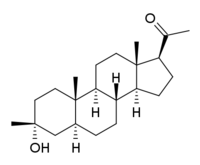Ganaxolone
 |
|
| Clinical data | |
|---|---|
| ATC code |
|
| Legal status | |
| Legal status |
|
| Identifiers | |
|
|
| Synonyms | CCD-1042 3β-Methyl-3α-ol-5α-pregnan-20-one; 3α-Hydroxy-3β-methyl-5α-pregnan-20-one |
| CAS Number | |
| PubChem CID | |
| ChemSpider | |
| UNII | |
| KEGG | |
| ChEMBL | |
| Chemical and physical data | |
| Formula | C22H36O2 |
| Molar mass | 332.520 g/mol |
| 3D model (Jmol) | |
|
|
|
|
|
|
|
Ganaxolone is an experimental CNS-selective GABAA modulator that is under development by Marinus Pharmaceuticals as an anxiolytic and anticonvulsant agent. Ganaxolone has been shown to protect against seizures in animal models, and to act a positive allosteric modulator of the GABAA receptor.
Ganaxolone is being investigated for potential medical use in the treatment of epilepsy. It is well tolerated in human trials, with the most commonly reported side effects being somnolence (sleepiness), dizziness, and fatigue. Trials in adults with focal onset seizures and in children with infantile spasms have recently been completed. There are ongoing studies in patients with focal onset seizures, PCDH19 pediatric epilepsy, and behaviors in Fragile X syndrome.
The exact mechanism of action for ganaxolone is unknown; however, results from animal studies suggest that it acts by blocking seizure propagation and elevating seizure thresholds.
Ganaxolone is thought to modulate both synaptic and extrasynaptic GABAA receptors to normalize over-excited neurons. Ganaxolone's activation of the extrasynaptic receptor is an additional mechanism that provides stabilizing effects that potentially differentiates it from other drugs that increase GABA signaling.
Ganaxolone binds to allosteric sites of the GABAA receptor to modulate and open the chloride ion channel, resulting in a hyperpolarization of the neuron. This causes an inhibitory effect on neurotransmission, reducing the chance of a successful action potential (depolarization) from occurring.
...
Wikipedia
